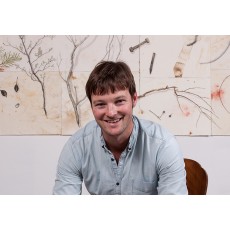Luke Shelley in Conversation with Noella Lopez

I first encountered Luke’s works at his graduation exhibition at National Art School (Sydney) a few years back. His etchings were personal, organic and inspiring. A year later, for his Honours graduation, he presented a true “installation” of ocean etchings, plates and found objects; a mature, deep, thoughtful and harmonious meditation layering his many discoveries, nature and his art practice. Since then Luke has explored the outback and more of the coast and created experimental tools to measure the impact of the elements and time on the environment. His body of work to date is a testimony to this unfolding adventure.
Your work takes great inspiration from natural science and your natural environment exploring the ocean and estuary system on the Central Coast. How do you think audiences react to your work?
I get a good response from the audience. My exhibitions seem to inspire people to share the fascinating adventures and experiences they have encountered in nature, which I like very much. I feel my work has an impact on people purely because most people relate to the environment we live in and experience every day. We hear about the glaciers melting, the amount of plastic in our oceans, and the impact we as a species are having on the planet; people are starting to become more conscious and passionate about the environment. I’ve been told my work evokes a sense of discovery, like an amateur naturalist. This is exactly what I want my work to be as this is who I am.
Your upbringing and your parents have also been great influencers on your art practice. How does this influence translate in your art practice now?
My family and my upbringing had a major impact on my practice as an artist. I had a privileged upbringing in the sense that firstly my parents had a small house on the edge of Brisbane Waters. Secondly, I was immersed as a child in my father’s knowledge and passion about the land and the things that live within it. I learned to walk in the bush, rather than through it, to notice the smallest things and to contextualise them in the ‘bigger picture’ of nature. I have vivid memories of beachcombing with him picking up sticks, shells, bones, bird feathers, seedpods, even interesting pieces of rubbish that had been floating around for some time, almost becoming part of the natural world. Beachcombing is now a major source of inspiration for my art practice heavily influenced by environment and experience, as well as a favourite pastime.
Like an amateur naturalist, you record the effects of time and the elements as well as interpret the alchemy of the collected found objects and seasonal changes. How did this process start initially with the ocean etchings process? And then continued with the time and tide apparatus constructed and exhibited as part of your art installation at Gosford Regional Gallery in 2013.
I’ve always been confident in my draughtsmanship, which is controlled and correct, but I’ve also always been fascinated by the natural marks that surround us in nature. Whether it be the eroded façade of a sandstone cliff, or the track of a sea snail in the mud, these markings, or drawings as I like to call them, are perfect. The ocean etching process really started as an experiment which followed an idea of attempting to record the erosive quality of the ocean. The scratches and pitting in the plates really emulate the erosive qualities of the ocean, and have an organic quality which cannot be matched by a human hand. These experiments started a whole new idea of ‘expressing nature’, or assisting nature in expressing itself. In parallel to the ocean etchings concept were plans to construct apparatus to record wind and tidal movements. The ‘emerging’ prize at GRG was an opportunity to construct these machines that had only existed as crude sketches in a sketchbook.
As part of your recent expeditions what are your next discoveries? How do you imagine articulating their essence? Any particular materials, techniques and processes you would like to work with?
I barely go a day without a sense of discovery. I recently moved into a small apartment with a studio space which looks over Brisbane Waters, the same waterway I grew up on. This place is really drawing back a lot of memories from my childhood; I’m constantly out on my veranda taking in the sights and sounds of the waterway. I’m always tinkering around trying to refine the drawing apparatus and experimenting with new ways to capture or record natural marks. I’ve been collecting a lot of natural and manmade artefacts that wash up on the shoreline. I’ve begun to build a body of work consisting of studies of these artefacts, partly influenced by scientific drawings or museum sketches. I’ve also been experimenting with staining the paper by leaving it in the mud at low tide, to soak up the rich colour and attempt to create a natural base colour palette. I like to think that the drawings of objects collected from the waterway will retain a small piece of the waterway with them.
Luke Shelley - June 2014
WATCH LUKE SHELLEY EXPERIMENTING WITH A WIND DRAWING APPARATUS
Write a comment
Your Name:Your Comment: Note: HTML is not translated!
Enter the code in the box below:
By posting this comment, you agree to abide by Noella Lopez Gallery Privacy Policy and Terms and Conditions.






